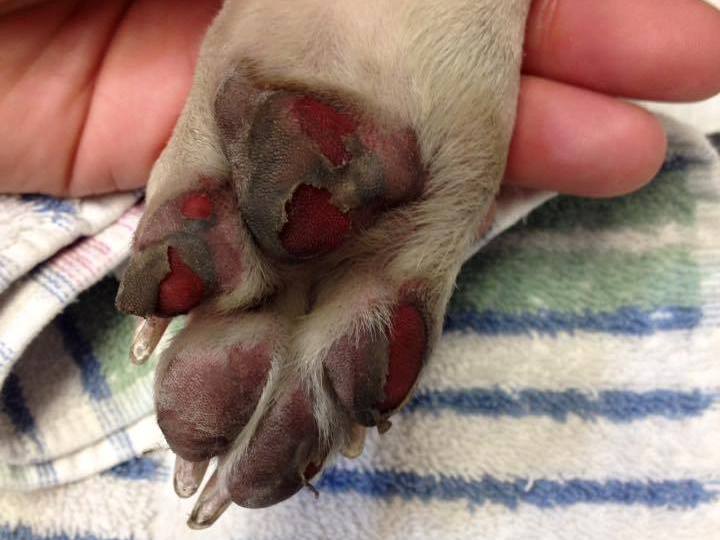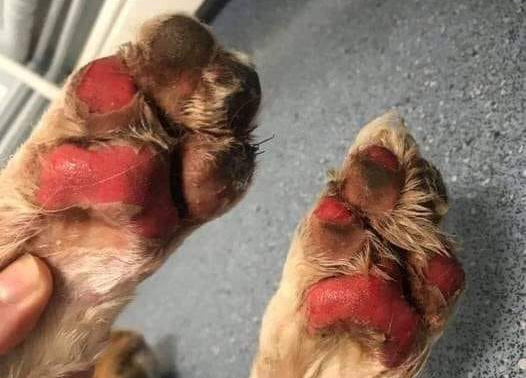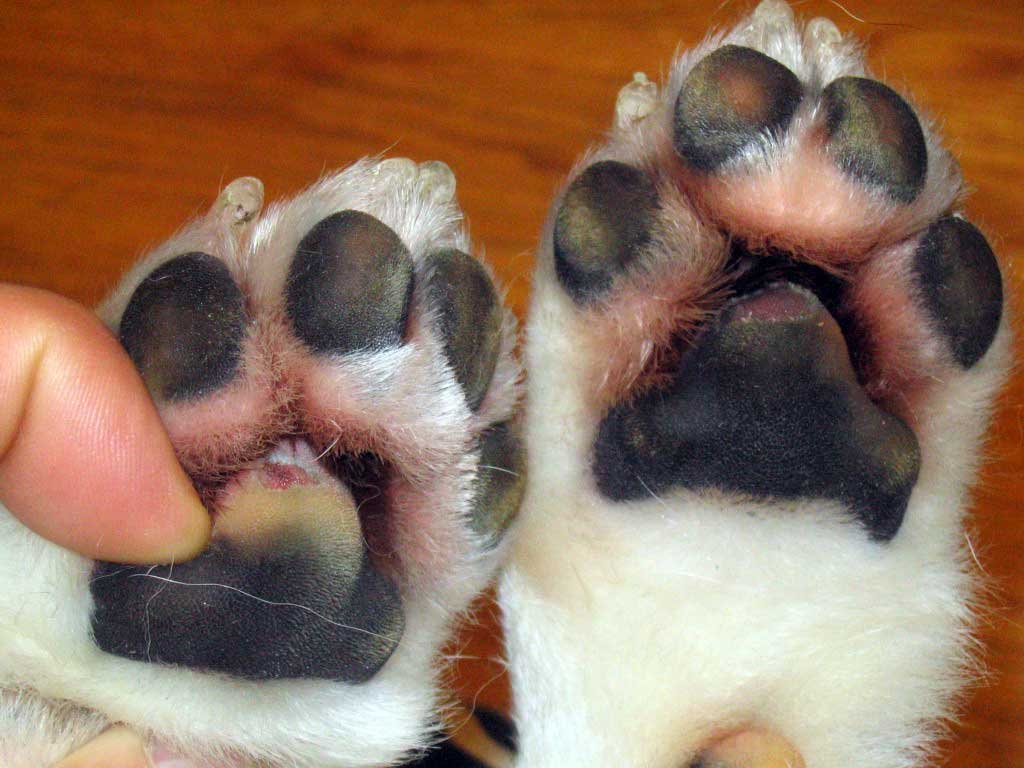Dog paw burns can be easily identified as red and ulcerated pads, which may form blisters and fill with fluid before rupturing. The typical treatment for paw burns includes detoxification, fluid therapy, pain relief medications, and possibly hospitalization.
It is important to rinse the affected area and remove any dead skin. The healing time for a paw pad burn can vary depending on the severity of the injury, with minor cuts healing within a few days to a week and more serious burns taking several weeks to heal.
It is crucial to seek veterinary care for deep or painful burns. Dog paw burns are often caused by hot pavement or chemical exposure. Taking preventive measures such as using protective paw lotion and avoiding hot surfaces can help prevent paw pad burns in dogs.
Causes Of Dog Paw Burns
Dog paw burns can be quite painful for our furry friends. It is essential to understand the different causes so that we can take preventive measures and provide timely treatment. In this article, we will explore three common causes of dog paw burns, including hot pavement, chemical burns, and other causes.
Hot Pavement
One of the leading causes of dog paw burns is hot pavement. During the summer months, pavement and concrete can become scorching hot, reaching temperatures that are unbearable for our canine companions. When dogs walk on such surfaces, their paw pads can quickly get burned, resulting in blisters and ulcers.
To put it in perspective, consider the fact that sidewalks can easily reach temperatures of 120 degrees Fahrenheit on a sunny day, which can cause severe damage to a dog’s sensitive paw pads. It’s crucial to be mindful of the pavement temperature before taking your dog out for a walk, especially during the hottest hours of the day.
Chemical Burns
Chemical burns are another cause of dog paw burns. Dogs frequently come into contact with various chemicals, such as cleaning agents, fertilizers, or even certain types of ice-melting products during the winter. These chemicals can be highly corrosive and can cause severe damage to the paw pads upon contact.
If you suspect that your dog has come into contact with a chemical that could potentially cause burns, it is essential to take immediate action. Rinse the affected area thoroughly with cool water to remove any residue. It is also advisable to seek veterinary attention, as chemical burns may require specialized treatment and care.
Other Causes
Aside from hot pavement and chemical burns, there are other causes that can lead to dog paw burns. These include walking on surfaces that have been recently treated with salt or ice-melting chemicals, exposure to excessive heat sources like fire or hot surfaces, and even minor cuts or abrasions that become infected.
To prevent paw burns from these causes, always be cautious about the surfaces your dog walks on and be mindful of any potential hazards. Regularly inspect your dog’s paws for any signs of injury or irritation, and seek veterinary attention if necessary.
In conclusion, understanding the causes of dog paw burns is crucial for their well-being. By being aware of the risks associated with hot pavement, chemical burns, and other potential causes, we can take proactive measures to protect our furry companions and provide them with the necessary care they deserve.
Symptoms Of Paw Burns In Dogs
Symptoms of paw burns in dogs are easy to see, with the burn appearing as red and ulcerated pads that may develop blisters and fill with fluid. Hot pavement or concrete are common causes, and proper treatment is necessary to aid healing.
Redness And Swelling
When a dog sustains a paw burn, one of the most noticeable symptoms is redness and swelling in the affected area. The burn causes inflammation, leading to the paw pad becoming visibly red and swollen. This can be easily observed and indicates that the dog has experienced some kind of burn on their paw.Blisters And Ulcers
Another symptom of paw burns in dogs is the presence of blisters and ulcers on the paw pads. Blisters may form as a result of the burn, filled with fluid that increases discomfort for the dog. Over time, these blisters may rupture, leading to the formation of painful ulcers. It’s essential to keep an eye out for these blisters and ulcers as they can worsen the dog’s condition if left untreated.Pain And Limping
Paw burns in dogs can cause significant pain and discomfort, which can be observed through their behavior. Dogs with paw burns may exhibit limping or reluctance to put weight on the affected paw. This is a clear indication that they are experiencing pain and trying to avoid any further pressure on the burned area. Monitoring their mobility and paying attention to any changes in their gait can help identify this symptom of paw burns. It is crucial to recognize these symptoms of paw burns in dogs to ensure timely treatment and relief for our furry friends. Redness and swelling, blisters and ulcers, and pain and limping are all indicators that a dog has sustained a paw burn. By being vigilant and proactive in addressing these symptoms, we can help our four-legged companions on their path to recovery.Treatment For Dog Paw Burns
If your furry friend has suffered from a paw burn, it’s crucial to provide them with the proper treatment to ensure a speedy recovery. Whether the burn is mild or severe, there are various methods you can use to alleviate their discomfort and promote healing. Read on to learn about the different treatment options for dog paw burns.
Home Remedies For Mild Burns
If your dog has a mild burn on their paw, there are several home remedies you can try to provide relief and aid in the healing process:
- Soaking in cool water: Soak the affected paw pads in cool water (not ice water) to help reduce pain and inflammation.
- Applying cool compresses: Apply cool water compresses to the burned area using a clean cloth, changing them frequently to maintain the cooling effect.
- Using aloe vera gel: Apply a small amount of pure aloe vera gel to the burn. Aloe vera has soothing and healing properties that can help relieve discomfort and promote faster healing.
- Using a paw protection balm: Apply a paw protection balm with natural ingredients to create a barrier between the burn and the ground, preventing further irritation and promoting healing.
Medical Treatment For Severe Burns
If the paw burn is severe and home remedies don’t provide sufficient relief, it’s essential to seek medical treatment from a veterinarian. In such cases, the following treatments may be necessary:
- Detoxification: The veterinarian may perform detoxification procedures to remove any chemicals or toxins from the burned area.
- Fluid and oxygen therapy: Dogs with severe burns may require fluid and oxygen therapy to stabilize their condition and support the healing process.
- Pain relief and infection medications: The veterinarian may prescribe medications to alleviate pain and prevent infection in the burn area.
- Hospitalization for observation: In extreme cases, the dog may need to be hospitalized for closer monitoring and specialized care.
Preventing Infections
Preventing infections is crucial when treating dog paw burns. Here are a few steps you can take:
- Keep the area clean: Regularly clean the burned area to prevent the buildup of dirt and bacteria.
- Topical antimicrobial ointments: Apply topical antimicrobial ointments recommended by your veterinarian to prevent infection.
- Protective booties: Consider using protective booties to keep your dog’s paws clean and protected from further injury or infection.
Remember, timely and appropriate treatment is essential when it comes to dog paw burns. By following these guidelines, you can help your furry companion recover from their paw burn as quickly and comfortably as possible.

Credit: naturaldog.com
Healing Time For Dog Paw Burns
When it comes to dog paw burns, the healing time can vary depending on the severity of the injury. Proper care and treatment are crucial for a speedy recovery. This article will provide information on the healing time for both minor and severe burns.
Minor Burns
Minor burns, such as cuts or abrasions, can often heal within a few days to a week with proper care. Here are some steps you can take to promote healing:
- Soak the paw pads in cool water, avoiding ice water, or apply cool water compresses with a clean cloth several times a day. This helps to reduce inflammation and provide relief.
- Gently clean the affected area with a mild antiseptic solution to prevent infection.
- Apply a thin layer of paw balm or ointment to keep the paw pads moisturized and protected.
- Keep your dog from licking or chewing the affected area by using a dog cone or covering their paws with dog boots.
- Monitor the healing progress and consult a veterinarian if the burn does not show signs of improvement or if your dog’s condition worsens.
Severe Burns
Severe burns, such as deep cuts or burns that involve a large surface area, may take several weeks to heal. In some cases, hospitalization and veterinary intervention may be necessary. Here are some additional steps to take for severe burns:
- Seek immediate veterinary attention for proper diagnosis and treatment.
- Follow the veterinarian’s instructions regarding wound care, medications, and possible hospitalization for observation.
- Keep the affected paw protected and clean at all times to prevent further infection.
- Provide a comfortable and quiet space for your dog to rest and recover.
- Administer any prescribed medications as directed by the veterinarian.
Remember, every dog is different, and the healing time can vary. It is essential to monitor your dog’s progress, follow veterinary advice, and provide them with the necessary care and attention during the healing process.
Preventing Dog Paw Burns
Protective Measures
Dog paw burns can be painful and inconvenient for our furry friends. Thankfully, there are several protective measures you can take to minimize the risk of burns. One effective method is to apply a protective paw lotion that forms a barrier between your dog’s paws and the walking surface. This lotion acts as a shield, preventing the paw pads from coming into direct contact with hot pavement, chemical hazards, or rough surfaces.
Choosing Appropriate Walking Surfaces
The type of walking surface your dog encounters plays a crucial role in preventing paw burns. Opt for surfaces that are not heat-absorbent, such as concrete or artificial grass. These materials tend to get extremely hot in the summer sun, increasing the risk of burns. Instead, consider walking your dog in shaded areas or on cooler surfaces, such as asphalt or dirt trails. Remember, prevention is key in keeping your dog’s paws safe and healthy.
Avoiding Chemical Hazards
Chemical hazards, such as road salts or ice melt products, can cause severe burns to your dog’s paws. To prevent these burns, avoid walking your dog on areas that have recently been treated with these chemicals. Additionally, thoroughly clean your dog’s paws after walks to remove any residue that may have been picked up along the way. Consider using paw-friendly wipes or a gentle rinse to ensure all traces of potentially harmful substances are eliminated.

Credit: www.vets-now.com

Credit: nndda.org
Frequently Asked Questions Of Dog Paw Burns
What Do Paw Burns Look Like?
Paw burns can cause visible symptoms like redness, ulcers, and blisters on the dog’s paw pads. Hot surfaces like concrete or pavement are common causes. Treatment may include rinsing the area, removing dead skin, and providing pain relief. Healing time varies based on the severity of the burn.
How Do You Treat A Chemical Burn On A Dog’s Paw?
To treat a chemical burn on a dog’s paw, start by rinsing the area with cool water and removing any dead skin. Detoxification, fluid therapy, and pain relief medications may be necessary. In some cases, hospitalization for observation may be required.
Seek veterinary assistance for severe burns or if the dog is in pain.
How Can I Soothe My Dogs Irritated Paws?
To soothe your dog’s irritated paws, you can try soaking them in cool water or applying cool water compresses with a clean cloth. Avoid using ice water. You can also apply a protective paw lotion to help heal the burns.
If the burns are severe or your dog is in pain, it is best to consult a veterinarian.
How Long Does It Take For Dog Paws To Heal?
The healing time for a dog’s paw pad can vary. Minor cuts or abrasions may heal within a few days to a week with proper care, while more serious injuries like deep cuts or burns may take several weeks to heal.
Conclusion
Paw pad burns. These burns can be quite painful and can even lead to blisters and ulcers. It’s important to take immediate action in treating and soothing your dog’s irritated paws. This can include rinsing the affected area, providing pain relief medication, and keeping a close eye on the healing process.
Remember, the healing time for paw burns can vary depending on the severity, so make sure to monitor your furry friend closely and seek veterinary attention if needed. With proper care and attention, your dog’s paw pads will heal in due time.

